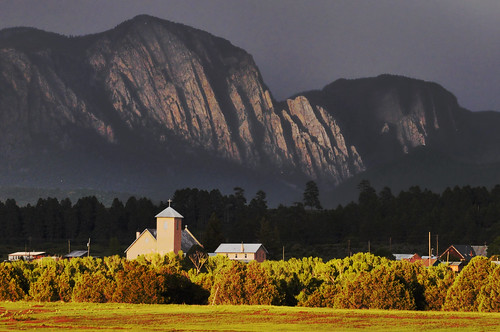What is a view worth?

And what is a true rural experience?
Gerald has chosen to "monetize" his blog, (Enter Title Here). That means he has allowed the host that sponsors his blog to put some advertising in the blog's sidebar, and if somebody clicks on one of those ads, he gets a tiny fraction of a cent (something like a hundredth).
It has been interesting to see what ads have shown up. Early on, when he had a lot of posts about his Jeep, many of the ads were related to that vehicle – places selling parts or offering customization or things like that. When he posted about helping to take care of the Old Soldier, the ads started coming up with recommendations for home-health-care options and lawyers who could help with guardianship issues.
Lately, Gerald has been putting up pretty pictures of Northern New Mexico scenery. The ads are now coming up for vacation rentals in Northern New Mexico, and for real estate in Northern New Mexico. The vacation rental ads seem quite reasonable – after all, a person looking at Gerald's photos of dramatic scenery in the aftermath of a thunderstorm sweeping through Abiquiu might be inspired to go there. One of the real-estate developers, however, seems to be utterly unrealistic.
Many, many long years ago, my folks and a couple dozen other families came together to form a land-owning cooperative. The idea was that these 24 people would buy a big chunk of mountain ranch land. Then each family would get a small piece of land upon which to build a vacation home, and the rest of the land would be run cooperatively as open space. At the time, this was an extremely novel idea. It didn't completely work. A few families did build vacation homes, but those tended to be primitive, as the land was remote enough that electric power couldn't be brought in, and without electric power to run wells, there was no running water. The co-op got some money from grazing leases and timber sales, but not much. The folks sold their share of the co-op a few years ago.
About the same time as the folks sold their share, people in California discovered this idea – a big tract of thousands of acres, with residential lots in environmentally friendly areas, often on the perimeter, and the rest owned as a cooperative, as a conservation tactic. This developer whose ad now shows up on Gerald's blog seems to endorse this philosophy. At first glance, it seems good: Rather than tearing down the forest to put up McMansions that all want to have the view but in the process of trying to get the view destroy it, restrict the number of McMansions, and preserve both the view and the natural environment that produces that view.
When word first arrived that a major developer from California had bought this ranch in order to develop it, the reaction in the Chama Valley was mixed. Some people thought it would be devastating; all of these rich Californians coming into the valley would wipe out, or at least marginalize, the local culture, which had been in place for hundreds of years. An influx of Californians might also artificially inflate real-estate values, as it had already done in Santa Fe, making property values go up to the point that families that had owned their homes for generations would lose them because the property taxes would go up. On the other hand, some argued, having all of these rich Californians moving in would mean that they would be spending money in local stores and employing local people to clean their houses and drive their cars, and so it would be good.
The developer certainly expected to gain a lot. The ranch has a total of 5700 acres, of which 4000 acres are to be reserved as conservation green space. The subdivision plan envisions the rest of the ranch being divided into 81 residential lots. The first batch of lots (with no utilities in place and no development except for possibly an access road) range in size from 11 acres (for $650,000) to 51 acres (for $795,000) and in price from $415,000 (for 14 or 18 acres) to the aforementioned $795,000, 51-acre lot.
As it turns out, all of the locals' worries and hopes are, at least for now, on hold. With the economy taking a nose-dive, especially in California, there aren't any California millionaires buying these lots. In this first batch of 24 lots, the developer has sold one, and one other is under contract. The rest are still up for grabs.
So what does a buyer get in exchange for paying $650,000 to get 11 acres? Mostly, a view. I looked at the map on the developer's website, and that lot is at the end of a peninsula of lots, on top of a point looking out over a canyon. It probably has some really good views.
But what kind of view is worth $650,000? The developer's website doesn't indicate a view all that much better than what I get at Five O'Clock Somewhere. OK, so my view includes a couple of other people's vacation cabins, so it can't pretend to be isolated from civilization. But my view includes a lake, and the $650,000 lot's view doesn't.
It is interesting experiencing this developer's website, at least to the extent that it can be experienced over a low-speed connection. The site is graphics-heavy, and there's a video that's apparently supposed to be the core of the presentation. What little I could get over a dial-up connection consisted of the sound of coyotes beginning to howl. I wonder, why would anybody spend $650,000 to buy a lot upon which, after spending more money to bring in utilities and then spending even more money to build a house, one could then hear coyotes howl? One can buy a $15 tent at Wal-Mart, or, if one prefers the finer things, a $35 tent at REI, pitch it just about anywhere, and hear coyotes howling.
Now here's an interesting thought … how much is a view really worth? If that view in the proposed development is worth $650,000, then the view from Five O'Clock Somewhere ought to be worth at least a couple hundred thousand. And what about the San Jose Church in Los Ojos? What's that view worth?
Labels: family, five o'clock somewhere, new mexico, observations, pretty pictures, rants, rio arriba county, tadpole



2 Comments:
One other thing ... the land cooperative that my folks used to be a member of was above and to the left of the cliffs in the photo of the San Jose church. I'm not sure exactly where, relative to the cliffs, the land with the super-expensive view is.
Update: I got curious about exactly where this land development was. The developers' map showing lot locations doesn't give the names of such things as the creek running through the property; it gives only the name of the canyon at the northern edge of the property.
So I went to the online USGS maps, and I looked at the land on the southern edge of the canyon until I found a creek and other landforms the same shape as those shown in the developers' map.
On the USGS map, the name of the creek running through this proposed development is the same as the name of the creek that ran through the co-op property that my folks used to own. The geographic contours of the development are, as best as I can tell, identical to those of the co-op. The last proposed phase of the development, called "Middle Mountain" on the developer's map, centers on a granite outcrop that looks an awful lot like the granite outcrop upon which the folks' lot was situated.
Post a Comment
<< Home